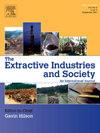到 2030 年,欧盟是否有足够的矿产来驱动他们的电动梦想?
IF 3.6
2区 社会学
Q2 ENVIRONMENTAL STUDIES
Extractive Industries and Society-An International Journal
Pub Date : 2024-10-11
DOI:10.1016/j.exis.2024.101556
引用次数: 0
摘要
为了实现在《巴黎协定》基础上制定的气候目标,即到 2050 年实现气候中立,欧盟(EU)政府将电动汽车(EV)视为一种变革性解决方案,并以此为基础制定了目标。然而,交通模式的电气化在很大程度上依赖于铝、钴、铜、石墨、锂、锰、镍和稀土元素等矿产,而这些矿产在国际上的供应和分布相当不平衡。因此,这项工作的目的是研究欧盟 2030 年的电动汽车目标是否可以通过目前全球可用的矿物数量来实现。我们开展了一项案头研究,收集有关电动汽车和电动汽车相关矿物的数据和知识,以了解其可用性和供应情况。这样就可以计算出每种材料的需求量,并确定是否可以满足 2030 年电动汽车转型目标。结果表明,到本十年末,石墨供应将出现危机,而由于交通领域向绿色能源系统的快速过渡,镍和钴的供应也将面临巨大危险。本文章由计算机程序翻译,如有差异,请以英文原文为准。
Will the EU have enough minerals to drive their electric dreams by 2030?
In order to achieve the climate goals, set on the basis of the Paris Agreement, i.e. to be climate neutral by 2050, the European Union (EU) governments consider electric vehicles (EVs) as an altering solution and have established their target based on that. However, the electrification of the transport modes depends heavily on minerals such as Aluminium, Cobalt, Copper, Graphite, Lithium, Manganese, Nickel, and Rare Earth Elements, whose availability and distribution are quite imbalanced internationally. The purpose of this work is thus to research whether the EU's 2030 targets for EVs can be satisfied with the amount of minerals that are currently globally available. A desk research was conducted to gather data and knowledge about EVs and EV-related minerals to shed light on their availability and supply. This allowed for calculating the demand for each material and enabled the determination of whether it could be satisfied in relation to the EV transformation targets for 2030. The results have shown that there will be a crisis in the graphite supply by the end of the decade and a considerable danger to the supply of nickel and cobalt due to the rapid transition to a green energy system in transportation.
求助全文
通过发布文献求助,成功后即可免费获取论文全文。
去求助
来源期刊

Extractive Industries and Society-An International Journal
ENVIRONMENTAL STUDIES-
CiteScore
6.60
自引率
19.40%
发文量
135
 求助内容:
求助内容: 应助结果提醒方式:
应助结果提醒方式:


